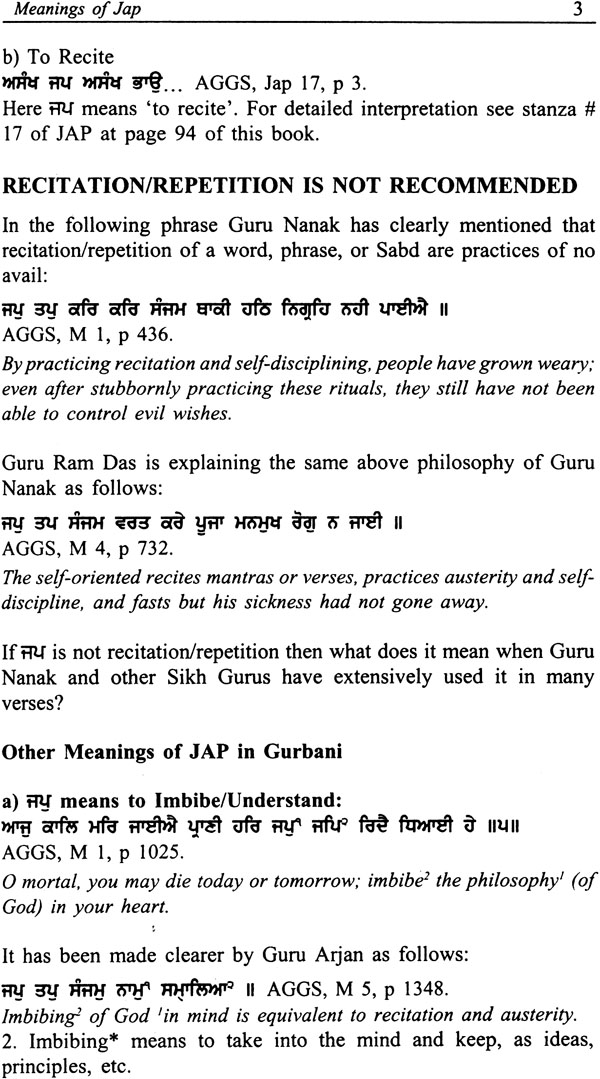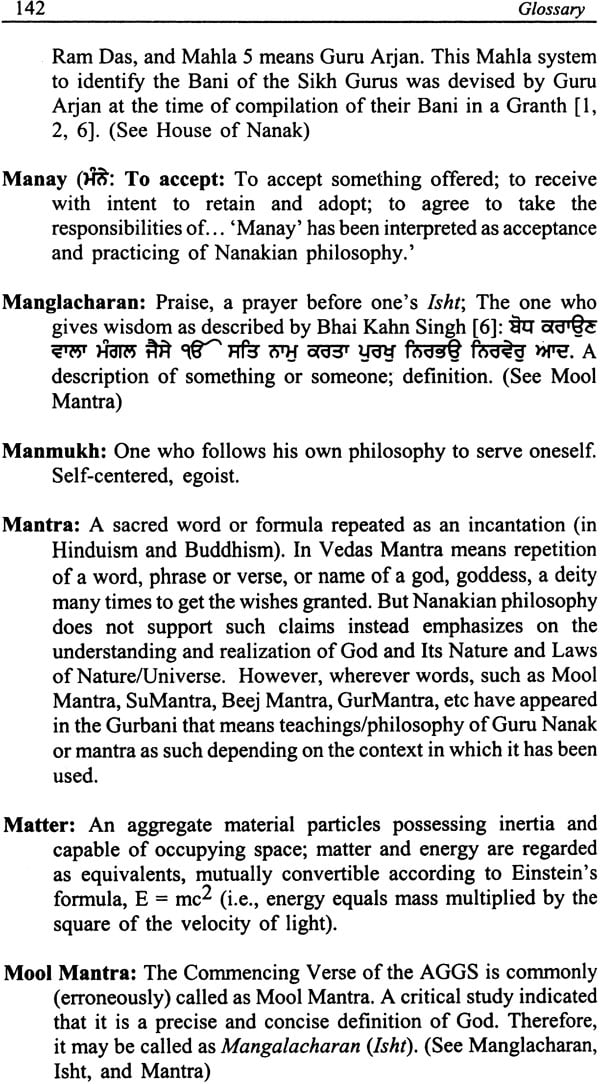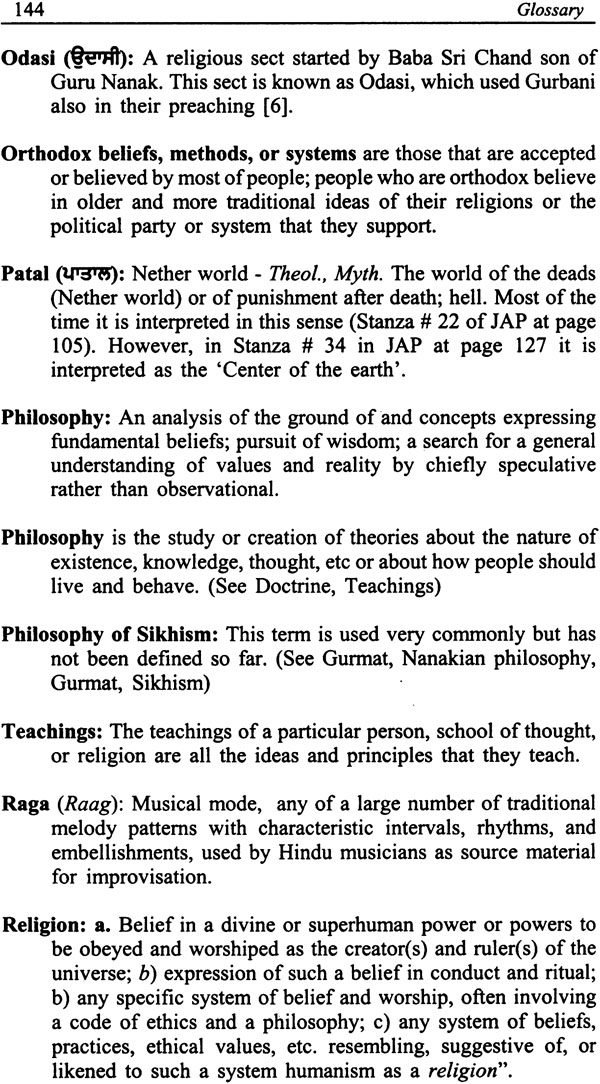
Jap: The Essence of Nanakian Philosophy {The Scientific and Logical Interpretation}
Book Specification
| Item Code: | IDK364 |
| Author: | Devinder Singh Chahal |
| Publisher: | Institute for Understanding Sikhism |
| Language: | Punjabi Text with English Translation |
| Edition: | 2003 |
| ISBN: | 0973429100 |
| Pages: | 166 (1 B/W & 1 Colour Illustration) |
| Cover: | Hardcover |
| Other Details | 8.7" X 5.5" |
| Weight | 340 gm |
Book Description
JAP: A Scientific and Logical Interpretation by Prof. Devinder Singh Chahal, PhD is a welcome addition to more than 200 commentaries on JAP written in various languages by different authors, Professor Chahal retired as Professor from the Institut Armand-Frappier, Universite du Quebec, Laval, Quebec, Canada and engaged himself in Sikh studies after retirement. Due to his professional training as a research scientist, he brings to bear the testimony of an analytical mind in interpretation of Gurbani. The litle of the book justifies the approach of the author. Prof. Chahal has mentioned five major categories of interpretation, as reported by Dr. Joginder Singh (1) in the Author's Note as Follow:
1. School of Meharbaan: Interpretation of this school are based on Vedas and Puranas.
2. School of Udasis: These interpretations are also based on Vedas and Puranas.
3. School of Nirmalas: Interpretations are based on Vedas. This school has introduced customs of Sanatana Dharma. One sentence is interpreted with more than one different meaning.
4. School of Gianis: Interpretations of Bhai Mani Singh and of Giani Badan Singh (Known as Faridkot Wala Teeka) are important ones.
5. School of Modern Scholars: Interpretation by Bhai Vir Singh, Bhai Jodh Singh, Prof. Sahib Singh, Principal Teja Singh, Dr Mohan Singh and many more contemporary scholars are included in this school. Although these interpretations are much better, still there is a lot of influence of Vedas and Puranas.
I may add that Professor Chahal's interpretation falls into the sixth category, which may be listed as School of Scientists. His interpretation is unique in some respects and may create reactions in orthodox circles not familiar with scientific approach.
JAP is the essence of Nanakian philosophy and is recited by Gursikhs (Sikhs of the Guru) as a morning prayer. Even before the compilation of the Aad Guru Granth Sahib (AGGS), the text of JAP (Gutka-booklet) was written by Guru Ramdas. It may be anticipated that written text of JAP was available to the Sikh Sangat (Congregation) established by Guru Nanak and his followers as mentioned by Bhai Gurdas, the great Sikh exponent, in his Vaars (odes).
Professor Chahal has explained the meaning of term JAP in the Part I of the book. The author implies that JAP is not mere recitation or repetition like a 'mantra' but it means to imbibe or understand after deliberation on the message of the Guru. In fact, Nanakian philosophy lays more stress on creating liberated role models (Gurmukh Guru-oriented persons) rather than stereotypes. Nanakian philosophy demolishes the concept of personal Guru-ship and establishes the 'Sabd' as 'Guru'. The import of this concept is noteworthy and had not been propagated properly by Sikh preachers and intellectuals till today. The book of Professor Chahal will promote the ideal of 'Sabd Guru' and his scientific approach will be appreciated by the youth educated in modern Science Age. The author claims (on page 10); "I have attempted to interpret JAP scientifically and logically so that the readers could understand the originality and uniqueness of the philosophy of Guru Nanak for uplifting their morality, inspiration, and to create a society of righteousness."
During the Fifth Centenary Celebration (1968-69) of Guru Nanak in the Punjabi University, Patiala, I was invited to deliver a lecture on cosmological concepts in Guru Nanak's Bani. I was wonder struck to find echo of modern scientific theories in JAP, Sidh Goshit and Maru Solhe Bani of Guru Nanak. My interest in the study of Gurbani was kindled by Professor D S Kotharia (Chairman University Grants Commission, New Delhi, India) and Professor Abdus Salam (Nobel Laureate, Director, International Centre for Theoretical Physics, Trieste, Italy) encouraged me to delve deep into scientific aspects of Nanakian philosophy. Professor Chahal has rendered a yeoman's service to the Sikh community by writing a scientific commentary on JAP for further exploration I was surprised that many established scholars of Sikh Lore, viz. Dr Mohan Singh, Bhai Jodh Singh, Principal Teja Singh, et al. are on slippery ground as discovered by Professors Chahal. For example, the opening verse of the first stanza of JAP has been wrongly interpreted by these worthies, translating as thought process. I fully agree with Professor Chahal's interpretation of as physical cleansing of body. In Gauri Sukhmani (AGGS, M 5, P 265), Guru Arjan used the same term and it implies what Professor Chahal interprets:
The Polluted mind cannot be cleansed by physical cleansing of body day and night.
It is my privilege as reviewer to impress upon the readers of this book the salient features and shortcomings, if any, in Professors Chahal's interpretation. I fully appreciate the scientific and logical approach, the style of rendering Gurbani into English using linguistic techniques and rules of grammar, reviewing works of other authors and providing references of all relevant text. Some unique features of interpretation are too obvious to be ignored. Professor Chahal of interpretation are too obvious to be ignored. Professor Chahal opines that is a unique world introduced by Guru Nanak and it should not be pronounced as Ik Oankaar or Ekankaar. He advocates a new pronunciation as ('IK+Oh+ Beant' One and only, that, Infinite) for to express both the Oneness and Infinite characteristics of the Supreme Reality (God). He has properly acknowledged the original work of Nirmal Singh Kalsi who first of all propounded this new hypothesis in the book, that should be pronounced as "Ikooooo" whereas Professor Chahal has gone a step further to make it more clear to pronounce as it written originally by Guru Nanak: Extended end of open Oora as (Ik+Oh+Beant).
It is a well-known fact that science and mysticism are two different modes of experiencing the Reality. While science lays stress on empirical facts and experimentation, mysticism relies more on intuition and transcendental experience. Gurbani belongs to the realm of mysticism as Guru Nanak proclaims that he preaches what he experiences in his mystic reveries. Prof. Chahal has tried to interpret into 'Gravitational Attraction' (page 86); into 'Big Bang' theory (page 93); and into fusion and fission ' page 119). Analogies are acceptable within certain limits but the purpose should not be to confuse the lay readers.
Some terms have gained currency in the Sikh literature; for example, is the ambrosial hour (generally 3 hours before the sunrise). Professor Chahal renders into 'anytime of tranquility', which may not be acceptable to Sikh Sangat as there are references to in the AGGS. Nevertheless, he has tried to justify his interpretation in the text.
Professor Chahal has obviously deviated from the beaten track of rendering the gurmukhi text of JAP into English. To make the rendering forceful, he has given theme headings on each Pauri (stanza) and provided its explanatory notes at the end. The driving force behind his interpretation of JAP seems to be his conviction that Nanakian philosophy is unique and original and borrows nothing from decadent Hindu philosophy. He is not the first and the last author to propagate this hypothesis. It was Professor Puran Singh, a great mystic poet and scientist of Punjab, who expounded the unique features of Nanakian philosophy in his writings during 1920's. Professors Puran Singh lamented that due to Brahmanical environment, the Guru's message has been misinterpreted:
"It is to be regretted that Sikh and Hindu scholars are interpreting Guru Nanak in the futile terms and dissecting texts to find the Guru's meaning to be same as of the Vedas and Upanishads. This indicates enslavement to the power of Brahmanical traditions." (Spirit of the Sikh, Part II Vol. 2 P 271. Punjabi University, Patiala India).
I am pleased to note that Professor Chahal is in resonance (working on the same wavelength) with Professor Puran Singh. I also wish, like the author, that more scientific interpretations of JAP should appear in the future to propagate the Nanakian philosophy of Sikh religion for the benefit of emerging global society of the twenty-first century.
"JAP a Scientific and Logical Interpretation by Prof. Devinder Singh Chahal, PhD is a welcome addition to more than 200 commentaries on JAP written in various languages by different authors. I am pleased to note that Professor Chahal is in resonance (working on the same wavelength) with Professor Puran Singh. I also wish, like the author, that more scientific interpretations of JAP should appear in the future to propagate Nanakian philosophy of Sikh religion for the benefit of emerging global society of the twenty-first century."
Dr. Hardev Singh Virk,
Professors of Physics
"I have attempted to interpret JAP scientifically and logically so that the readers could understand the originality and uniqueness of Nanakian philosophy for uplifting their morality, inspiration, and to create a society of righteousness."
The Author.
JAP is such on important part of Gurbani that it has been incorporated at the beginning of the Aad Guru Granth Sahib (AGGS). Due to its importance in the lives of the Sikhs JAP has been interpreted and translated into many languages of the world by many scholars of various faiths. It is estimated that there are hundreds of such interpretations since its realization by Guru Nanak sometime during the 15th or 16th century.
Since there are already many interpretations of JAP in Punjabi as well as in English and other languages, then the questions is; What is the need of another interpretation of JAP? Critical analyses of many of te interpretations of JAP indicate that they are heavily dominated with ancient philosophy and mythology where the real theme of Nanakian philosophy has been lost altogether. There fore, the author has attempted to interpret JAP scientifically and logically so that the readers could understand the originality and uniqueness of the Nanakian philosophy to understand the philosophy enshrined in the AGGS, in its real prespective.
Professor Devinder Singh Chahal, PhD retired on October 1, 1996 from the position on Professor of Applied Microbiology from a Canadian University. During his scientific professional life he has written many articles on scientific and logical interpretation of Gurbani and representation of Sikhism in various journals of the world and in many multi-authored books. He has also written a few critical analyses of some works on Sikhism and Gurbani. This book is based on his experience gained through discussion with Sikh scholars, the inquisitive questions by young Sikhs and by applying his scientific knowledge and logic in interpreting Gurbani.
| | ||
| Acknowledgements | i | |
| Foreword | iii | |
| Author's Note | vii | |
| Table of Contents | xi | |
| | ||
| Meanings of Jap | 1 | |
| Time of Realization | 4 | |
| Structure of (JAP) | 5 | |
| Controversy About the Authorship of Sloks | 6 | |
| Misinterpretation of Gurbani | 9 | |
| References | 10 | |
| | ||
| Nanakian Methodology | 13 | |
| Types of Expressions in Gurbani | 13 | |
| Difficulties to Understand Bani Being in Poetical Form | 17 | |
| Definitions and Terms | 18 | |
| Sources of Meanings | 18 | |
| Feed Back | 18 | |
| Interpretation of Gurbani | 19 | |
| Addressing God | 19 | |
| Presentation of Punjabi or Other words | 20 | |
| System of Referencing Bani From Aad Guru Granth Sahib | 20 | |
| References | 20 | |
| | ||
| The Commencing Verse of The Aad Guru Granth Sahib | 23 | |
| Introduction | 23 | |
| Interpretation of the Commencing Verse | 23 | |
| To | 31 | |
| Pronunciation of | 47 | |
| Updated Interpretation | 47 | |
| Representation of Commencing Verse in Aggs | 50 | |
| Conclusions | 53 | |
| References | 54 | |
| | ||
| JAP: The Essence of Nanakian Philosophy | 57 | |
| The Commencing Verse of The Aad Guru Granth Sahib | 59 | |
| Definition/ Attributes of God/ Manglacharan | 59 | |
| JAP | 61 | |
| Existence of God | 61 | |
| 1. Purification to Achieve Peace of Mind | 62 | |
| 2. Laws of Universe' | 65 | |
| 3. The Almighty is above all the attributes | 66 | |
| 4. How To please the almighty? | 67 | |
| 5-1. Neither Can be Structured nor created | 72 | |
| 5-2. God Beyond any Description | 73 | |
| 6. Bathing at Holy places is of no avail | 74 | |
| 7. Long life and fame are nothing without the grace of the almighty | 76 | |
| 8. Listening Makes one Understand | 77 | |
| 9. Listening Makes one Understand | 78 | |
| 10. Listening Makes one Understand | 79 | |
| 11. Listening Makes one Understand | 80 | |
| 12. Accepting means to undertake | 81 | |
| 13. Effects of Accepting | 82 | |
| 14. Effects of Accepting | 83 | |
| 15. Effects of Accepting | 84 | |
| 16-1. Reward for the nobles | 85 | |
| 16-2. Myth of White Bull Disapproved | 86 | |
| 16-3. Countless Living Beings | 88 | |
| 16-4. Creation of Universe/ Nature | 93 | |
| 17. Countless Devotees | 94 | |
| 18. Countless Wicked | 95 | |
| 19-1. Importance of Alphabet/Words | 96 | |
| 19.2. Manifestation of Almighty | 97 | |
| 20. Different Processes of Purification for Different Types of Pollutions | 98 | |
| 21-1. No Reward for bathing at Holy places | 100 | |
| 21-2. Time of Creation | 101 | |
| 22. Cosmos | 105 | |
| 23. God is incomprehensible | 107 | |
| 24. Infiniteness | 108 | |
| 25-1. God is Bounteous Entity | 109 | |
| 25-2. God is Bounteous Entity | 110 | |
| 26-1. Priceless Virtues | 111 | |
| 26-2. Attempts to Describe God | 112 | |
| 26-3. Many are Talking about the Greatness | 113 | |
| 27-1. Where does God live? | 114 | |
| 27-2. Everybody Praises God | 115 | |
| 27-3. Everybody Praises God | 116 | |
| 27-4. Immortal God Exists Forever | 117 | |
| 28. Yogi is advised about the meanings of their practices | 118 | |
| 29. Yogi is advised about miracles, fusion, and fission | 119 | |
| 30. Trinity or on entity | 123 | |
| 31. God exists everywhere | 124 | |
| 32. Repetition of God's Name | 125 | |
| 33. No One has power to change laws of universe | 126 | |
| 34. Natural Resources and Phenomena | 127 | |
| 35-1. Realm of Righteousneous | 128 | |
| 35-2. Realm of wisdom/knowledge | 129 | |
| 36-1. Realm of wisdom/knowledge | 130 | |
| 36-2. Realm of Initiative | 131 | |
| 37-1. Realm of Deeds | 132 | |
| 37-2. Realm of Universe | 133 | |
| 38. Coining Sabd and amrit (Elixir) | 136 | |
| Slok 1. Natural Resources | 137 | |
| | ||
| Glossary | 139 | |
| About the Author | 149 | |
| About Institute for Understanding Sikhism | 150 | |
| Figures | ||
| Figure1. Title page of 'Gurmat Gian' | 31 | |
| Figure 2. Milky Way Our Galaxy | 106 | |













